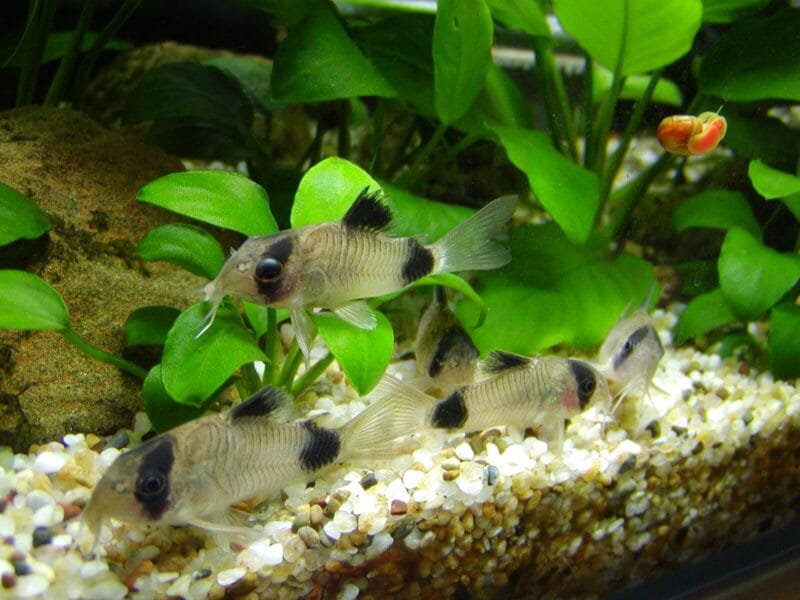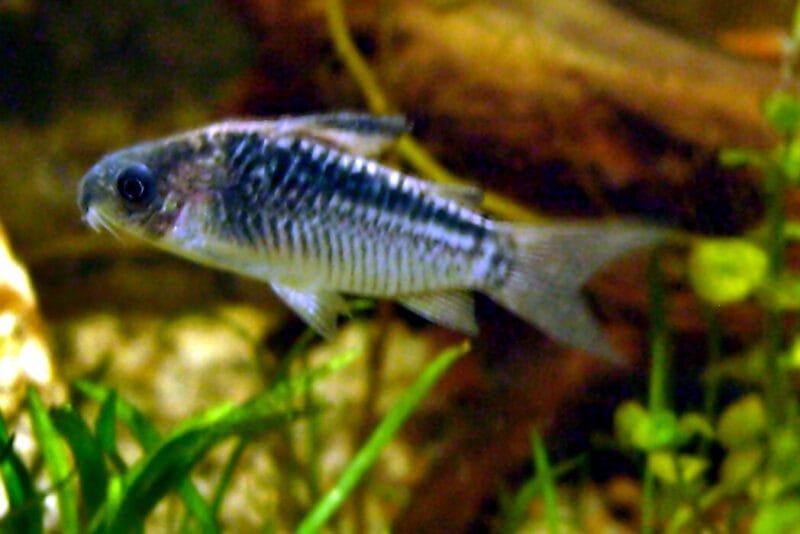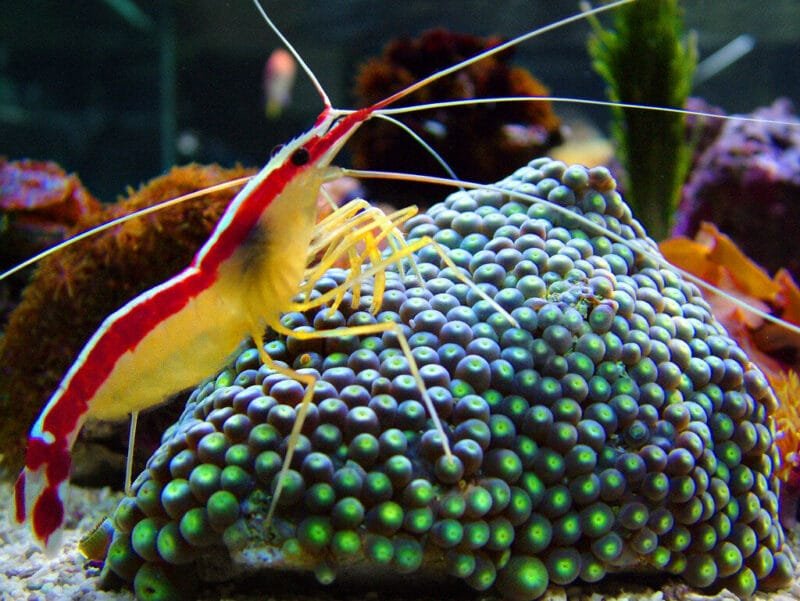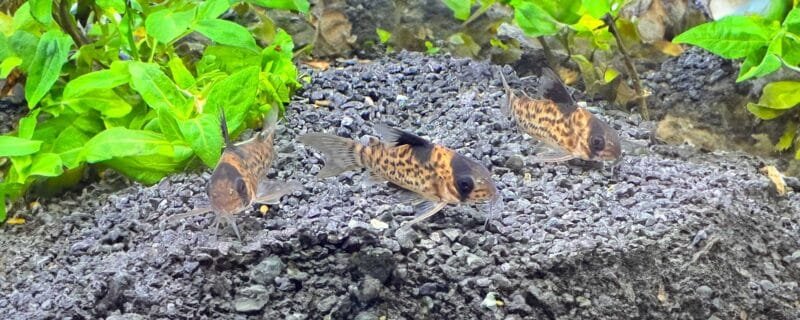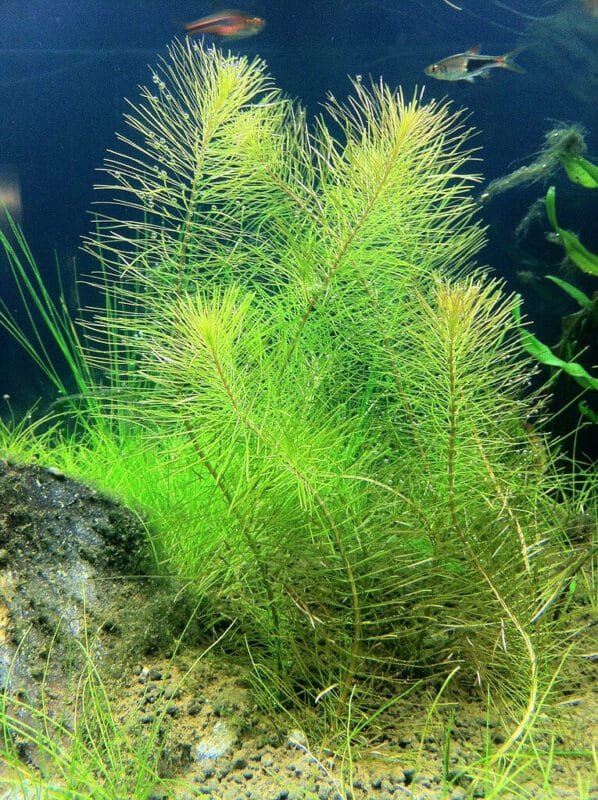The Corydoras pygmaeus, commonly known as the Pygmy Cory, is one of the smallest and most charming members of the Corydoras genus. Native to the soft, slow-moving waters of the Madeira River basin in Brazil, these diminutive catfish are a favorite among nano tank enthusiasts for their peaceful nature, active schooling behavior, and endearing appearance.
Overview of the Species
Common Name: Pygmy Cory
Latin Name: Corydoras pygmaeus
Family: Callichthyidae
Native to: South America (Madeira River basin, Brazil)
Relatives: Corydoras hastatus, Corydoras habrosus, and other miniature Cory species
Size and Appearance
Pygmy Corydoras are truly tiny, growing only up to 3 cm (1.2 inches) in length. Unlike most Corydoras species, which dwell primarily at the bottom of the tank, Corydoras pygmaeus are mid-water swimmers, often seen darting around in groups. Their silver bodies are accentuated with a distinct black horizontal line running from the snout to the tail, and they have clear fins and a compact, rounded body shape.
There is also an albino variation of Corydoras pygmaeus. The Albino Pygmy Cory exhibits a soft white-pinkish hue, with red eyes and the same small size and active swimming style as its standard counterpart.
Diet
Pygmy Corys are omnivores with a preference for small, soft foods. In the wild, they feed on microfauna, detritus, and plant matter. In the aquarium, they readily accept:
-
Crushed flakes
-
Micro pellets
-
Live or frozen baby brine shrimp
-
Daphnia
-
Microworms
-
Repashy gel foods
They have small mouths, so food must be finely crushed or sized for nano fish.
Water Conditions
To mimic their natural habitat, keep Pygmy Corys in soft, slightly acidic to neutral water. Ideal parameters include:
-
Temperature: 22–26°C (72–79°F)
-
pH: 6.0–7.5
-
Hardness: Soft to moderately hard (2–15 dGH)
-
Tank Size: Minimum 10 gallons, ideally in a long horizontal tank
Though tiny, they are active swimmers, and they benefit from horizontal swimming space and plenty of live plants or fine-leaved aquascaping.
Ease of Care
Pygmy Corys are relatively easy to care for, making them great choices for beginners who can provide stable water conditions and appropriate food. Key care points include:
-
Keep in groups of at least 6 (preferably 10+) to promote natural schooling behavior
-
Perform regular water changes
-
Use soft substrate like sand to protect their barbels
-
Avoid aggressive tank mates
They are highly social and thrive in peaceful community aquariums.
Breeding
Breeding Corydoras pygmaeus is possible in home aquariums and follows similar patterns to other Corys:
-
Condition with live foods
-
Perform cooler water changes to trigger spawning
-
Provide broad leaves or glass surfaces for egg-laying
-
Adults may eat the eggs, so separate fry or use a breeding box
Eggs hatch in about 3–5 days, and fry can be fed with infusoria or powdered fry food initially, followed by baby brine shrimp.
Sexing is subtle—females are slightly rounder and larger when mature, especially when viewed from above.
Tank Mates
Because of their gentle nature and small size, Pygmy Corys do best with equally peaceful species, such as:
-
Small tetras (e.g., Ember Tetras)
-
Rasboras (e.g., Chili Rasboras)
-
Celestial Pearl Danios
-
Shrimp and snails
-
Other nano Corydoras species
Avoid large or boisterous fish that may outcompete them for food or intimidate them.
Species Variations
Although the Pygmy Cory (Corydoras pygmaeus) is distinct, it’s often confused with:
-
Corydoras hastatus – has a distinct spot on the tail
-
Corydoras habrosus – more bottom-dwelling and stockier
Each of these “micro Corys” have different behaviors and appearances, making them all unique in a planted tank setup.
As mentioned earlier, there is also an Albino Pygmy Corydoras, which is rarer in the trade but shares all the same care needs. Its pale body and red eyes make it stand out in planted tanks, especially when mixed with normal morphs.
Community Tank Suitability
-
Community-Friendly: Yes
-
Reef Safe: Not applicable (freshwater species)
-
Ideal Setup: Nano community tanks, heavily planted aquascapes, or species-only biotopes
-
Reacts Well to: Low-light setups, calm currents, and soft substrates
Because of their tendency to swim at all levels of the tank, including mid-water, Pygmy Corys add dynamic movement and balance to planted layouts.
Summary
The Corydoras pygmaeus is a delightful species for aquarists looking to add personality and movement to a nano or planted tank. Their peaceful nature, manageable size, and schooling behaviors make them an excellent fit for both beginners and advanced hobbyists. Whether you’re setting up a South American biotope or just adding charm to your aquascape, the Pygmy Cory is a perfect little companion.

